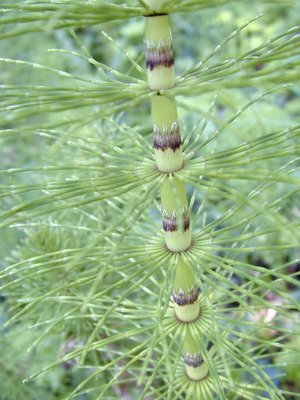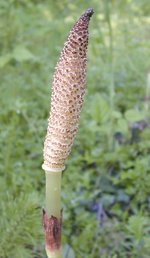Horsetail
|
|
| Horsetail | ||||||||||||
|---|---|---|---|---|---|---|---|---|---|---|---|---|
 Vegetative stem of Equisetum telmateia with a whorl (at each node) of branches and dark-tipped leaves | ||||||||||||
| Scientific classification | ||||||||||||
| ||||||||||||
| Species | ||||||||||||
Equisetum arvense - Field or Common Horsetail
Equisetum giganteum - Giant Horsetail |
The horsetails comprise 15 species of plants in the genus Equisetum. This genus is the only one in the family Equisetaceae, which in turn is the only family in the order Equisetales and the class Equisetopsida. This class is now usually placed as the sole member of the Division Equisetophyta, though some authorities place it instead in the Division Tracheophyta or Archeophyta. The plants in the genus Equisetum are considered fern allies. Other classes and orders of Equisetophyta are known from the fossil record, where they were important members of the world flora during the Carboniferous period.
The name horsetail arose because it was thought that the stalk resembled a horse's tail; the name Equisetum is from the Latin equus, "horse", and seta, "bristle". Other names, rarely used, include candock (applied to branching species only), and scouring-rush (applied to the unbranched or sparsely branched species). The name scouring-rush refers to its rush-like appearance and, because the stems accumulate abrasive silica, their being used for scouring cooking pots in the past.
The genus is near-cosmopolitan, being absent only from Australasia and Antarctica. They are winter-deciduous (temperate species) or evergreen (some tropical species), and are mostly 0.2-1.5 m tall, though E. telmateia can exceptionally reach 2.5 m, and the tropical American species E. giganteum 5 m, and E. myriochaetum 8 m.
These are plants without conspicuous leaves, but with hollow, jointed, ascending stems that may or may not have side-branches radiating out from the nodes, depending on species. The stem is ridged and grooved, with from (3-) 6-40 ridges. The leaves are minute, pointed-triangular, and form in a whorl at each node on the stem; there is one leaf for each ridge on the stem.
The spores are borne in a cone-like structures (strobilus, pl. strobili) at the tip of some of the stems. These reproductive stems are often unbranched, and in some species are non-photosynthetic and produced early in spring separately from photosynthetic sterile stems. Horsetails are mostly homosporous, though in E. arvense, smaller spores give rise to male prothalli. The eusporangia have an annulus that act as a moisture-sensitive spring, ejecting the spores through a weak spot of the sporangia.
Many plants in this genus prefer sandy soils, though some are aquatic and others adapted to wet clay soils. One horsetail, E. arvense, can be a nuisance weed because it readily regrows after being pulled out. The stalk-producing rhizome is deep underground and almost impossible to dig out. It is also unaffected by many herbicides designed to kill seed plants. The foliage is poisonous to grazing animals if eaten in large quantities.
The horsetails were a much larger and more diverse group in the distant past before seed plants became dominant across the earth. Some species were large trees reaching to 30 m. The genus, Calamites (Family Calamitaceae), is abundant in coal deposits from the Carboniferous period.
The superficially similar flowering plant, Mare's tail (Hippuris vulgaris), unrelated to the genus Equisetum, is occasionally misidentified and misnamed as a horsetail.
External links
- UK National Collection (http://www.btinternet.com/~pigott/equisetum/) - includes a taxonomic list of all known species and hybrids
- The Wonderful World of Equisetum (http://members.eunet.at/m.matus/)
- Giant horsetails (http://www.fiu.edu/~chusb001/giant_equisetum.html)
- Equisetum hyemale (http://www.floridata.com/ref/e/equi_hye.cfm)da:Padderok-familien (Equisetaceae)
de:Schachtelhalmgewächse es:Equisetum fa:دماسبی (گیاه) fr:Prêle he:שבטבט גדול ja:スギナ nl:Equisetum no:Sneller fi:Kortteet


